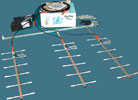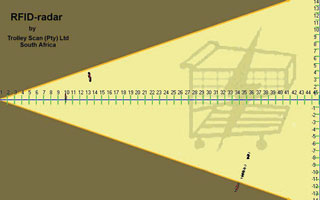
Trolley Scan has announced the first delivery of its recently commercialised version of 'RFID-radar' technology to clients based in Europe. Says Mike Marsh, Trolley Scan managing director and inventor of RFID-radar: "The delivery of the first RFID-radar system to our client in Europe (an IT company), marks the end of a hectic six months of development. Just six months ago we stumbled by chance, on a method of measuring the distance, with great accuracy and over long distances, that a signal travelled from a transponder back to a reader."
"The breakthrough with RFID-radar is the ability to measure the distance travelled by a signal from a transponder to a reader accurately, using minimal radio spectrum to reduce effects on other users, and with very low cost transponders and readers. We have had to build concept-proving equipment, conduct extensive field tests and design the first version of the commercial equipment," he says.

"The testing included 14 000 range measurements to verify consistency and accuracy. The system contains four parallel computers to perform the massive numerical calculations for which we had to write and debug thousands of lines of code. In addition we had to write handbooks for the operators," he says.
"The new technology will result in the development of an entire new set of applications for computer-based equipment," notes Marsh. "Applications could include the location of goods in a warehouse; tracking of individual animals in a herd; the monitoring of the movement of assets in a building; the location of parcels and airline luggage in a warehouse; the monitoring of children in a creche; or the monitoring of security zones to ensure sensitive areas are avoided. As all measurements are performed from one set of antennas, the equipment can even be mounted on a forklift truck to locate goods in a warehouse relative to the current position of the vehicle."

According to Marsh, the commercialisation will promote the development of longer range RFID systems, using lower power passive transponder technology. The delivered system operates in the EU RFID band at 869,5 MHz with very low power. Due to the wideband nature of the transponders, and the flexibility of the reader, the system can be set to operate at any of the UHF frequencies in the 860-960 MHz bands, making it suitable for use in all countries. Currently, operating ranges of 40 m are practical, but Marsh expects this to extend to 100 m in the near future.
What is RFID-radar?
RFID-radar is a new development that includes a measurement of range from the reader to the transponder. This measurement is made repeatedly allowing the reader to report range and tracking information for all transponders in the zone. The major development comes from the ability to measure the range accurately from a single reader position. This single measurement point allows mobile operation, as well as 2D and 3D location information of all transponders in the zone.
Measurement of range is considered a major breakthrough, as the radio signals travel at 300 000 km/s and the timing accuracy measurements are limited to 1/10 000th of a second. The RFID-radar has to operate in the very limited radio spectrum shared with the many users who use radio devices, such as cellphones. RFID-radar uses a mere 10 kHz of radio spectrum and is 'environmentally-friendly' such that two RFID-radar systems can operate within 4 m of each other.
RFID-radar delivers positioning accuracy of each transponder in the zone to 0,5 m with a maximum range of 100 m. The pointing accuracy of a vector for locating in 2D and 3D can be as accurate as 1° for each transponder.
The addition of position information encourages the development of much further scanning range from single readers and lower power transponders, as now, the identity and exact location can be determined.
For more information see www.rfid-radar.com or contact Mike Marsh, Trolley Scan, +27 (0)11 648 2087, [email protected]
| Tel: | +27 10 237 0675 |
| Email: | [email protected] |
| www: | www.trolleyscan.com |
| Articles: | More information and articles about Trolley Scan |

© Technews Publishing (Pty) Ltd | All Rights Reserved